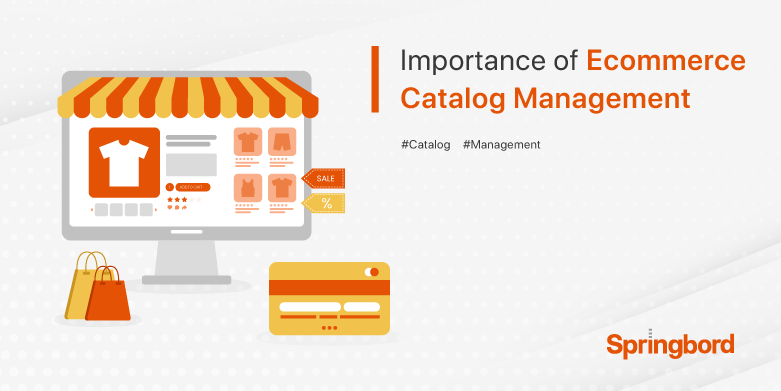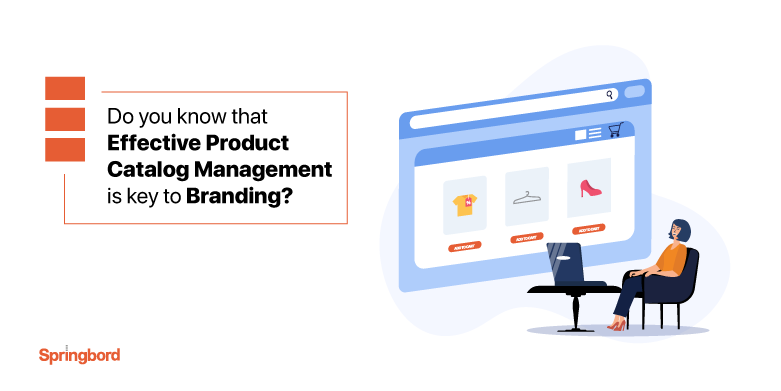 Read time 5 min
Read time 5 minOnline retail catalog management can be overwhelming for retailers. With so many products to keep track of, it can be difficult to stay organized.
Luckily, there are a few simple tips that can help simplify the process. In this blog post, we’ll explore five tips that retailers can use to streamline their online retail catalog management. From automating tasks to implementing effective organization strategies, these tips will help retailers save time and increase efficiency. With the help of Springbord, retailers can easily manage their online catalogs and stay on top of their inventory.
Retailers can find it hard to manage their online retail catalogs, especially when they have to keep track of thousands of products, manage their inventory, and update prices and product descriptions. But with the right tools and plans, retailers can simplify how they manage their online catalogs and save time and money in the process.
In this blog, we will be discussing 5 tips to simplify online retail catalog management for retailers using the services of Springbord, a leading provider of e-commerce solutions.
Validate All Product-Related Information
When it comes to managing an online retail catalog, one of the most important things to do is to validate all product-related information. This includes things like product names, descriptions, pricing, and images. By ensuring that all of this information is accurate and up-to-date, retailers can help to prevent confusion and frustration among customers and help to ensure that they are able to find and purchase the products they are looking for.
One way to validate product-related information is to use a spreadsheet or database to keep track of all of the relevant information. This can help to ensure that all of the information is accurate and up-to-date and can also make it easier to spot any errors or inconsistencies.
Another way to validate product-related information is to use a tool such as the Product Information Management System (PIMS). This system can help to automate the process of validating product-related information, and can also help to ensure that all of the information is accurate and up-to-date.
Maintain Uniformity in Displaying Product-Related Information
Keeping the way information about products is shown consistently is another important part of running an online retail catalog. This can help to make it easier for customers to find and compare products and can also help to ensure that all of the information is accurate and up-to-date.
One way to maintain uniformity in displaying product-related information is to use a template or set of guidelines for how the information should be presented. This can make it simpler to spot any errors or inconsistencies and help guarantee that all of the data is presented in the same way throughout.
Using a tool like PIMS is another way to make sure that information about products is shown in the same way everywhere. This system can aid in the automated maintenance of uniformity in the presentation of product-related information, thereby increasing the likelihood that said information is both accurate and up-to-date.
Deploy Product Information Management System (PIMS)
One of the most effective ways to simplify online retail catalog management is to deploy a Product Information Management System (PIMS). A PIMS can help to automate many of the tasks associated with managing an online retail catalog, and can also help to ensure that all of the information is accurate and up-to-date.
One of the key benefits of using a PIMS is that it can help to automate the process of validating and maintaining product-related information. This can facilitate the detection of any inaccuracies or discrepancies and ensure that all information is current and accurate.
Another benefit of using a PIMS is that it can help to automate the process of maintaining uniformity in the way that product-related information is displayed. This can ensure that all information is correct and up-to-date, which in turn facilitates the search for and comparison of products by customers.
Smartly Define Your Website’s Structure
When it comes to managing your online retail catalog, the first step is to ensure that your website is structured in a way that makes it easy for customers to navigate and find what they are looking for. This means that you should take the time to think about how your products are organized, and how they will be presented to customers.
One way to do this is to create a clear hierarchy for your products, with categories and subcategories that make it easy for customers to drill down and find the products they are looking for. This can include things like product type, brand, price range, and more.
Another important aspect of website structure is to make sure that your product pages are easy to understand and navigate. This means that you should include clear and concise product descriptions, high-quality images, and detailed information about the product, such as size, weight, and dimensions.
Finally, it is important to make sure that your website is easy to use on mobile devices. With the majority of customers now shopping on their smartphones, it is essential that your website is optimized for mobile devices, with a responsive design that adapts to different screen sizes.
Make it SEO-Friendly
Another important aspect of managing your online retail catalog is to make sure that your website is SEO-friendly. This means that you should take the time to optimize your website for search engines so that it is more likely to appear at the top of search engine results when customers are looking for products like yours.
Incorporating keywords into your page titles, meta descriptions, and product descriptions is one SEO best practice that can help boost your site’s visibility. Additionally, it’s important to make sure that your website is easy to crawl and indexed by search engines by making sure that your site’s structure is clear and organized.
Making sure your website is linked properly is a crucial part of search engine optimization. This means that you need to put in the effort to acquire links to your site from other websites, such as social media profiles, directories, and other related websites. This will help to boost your website’s visibility and rankings in search engine results.
Lastly, you should monitor your website’s statistics on a regular basis and make changes as necessary. This entails keeping tabs on your site’s traffic, bounce rate, and conversion rate, as well as its position in the search engine results in pages. By making regular adjustments to your website based on this data, you will be able to ensure that your website is always performing at its best.
Conclusion:
In conclusion, online retail catalog management can be a challenging task, but with the right tools and strategies, retailers can simplify the process and save time and resources.
Springbord, a leading provider of e-commerce solutions, can help retailers streamline their online catalog management process and ensure that their products are always up-to-date and easily accessible to customers.
By implementing the tips discussed in this blog, retailers can improve their online catalog management process and focus on growing their businesses.







